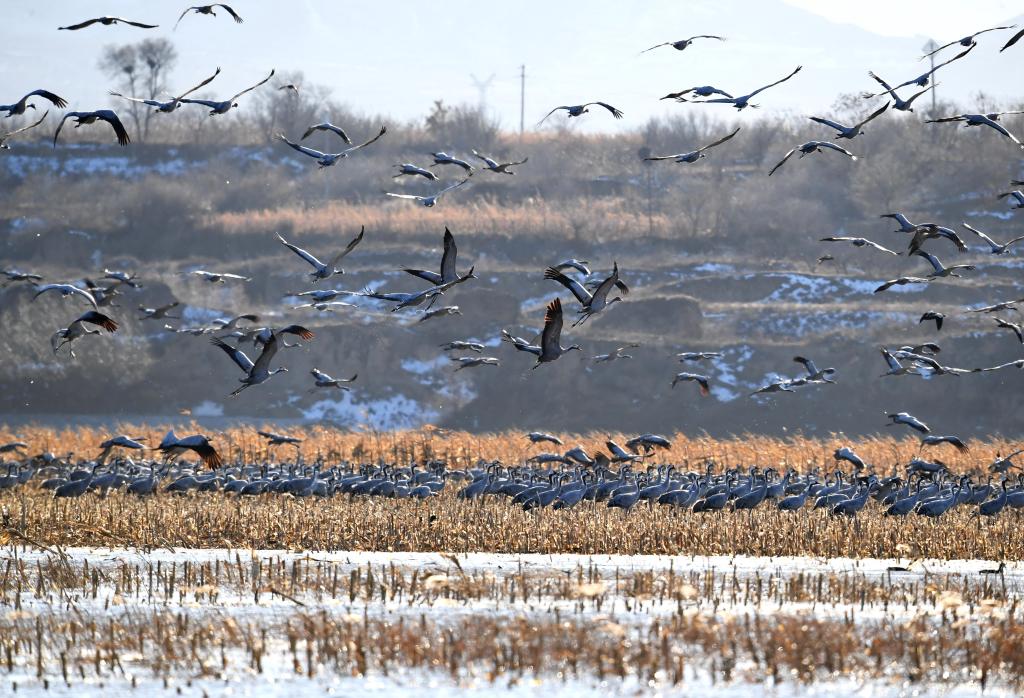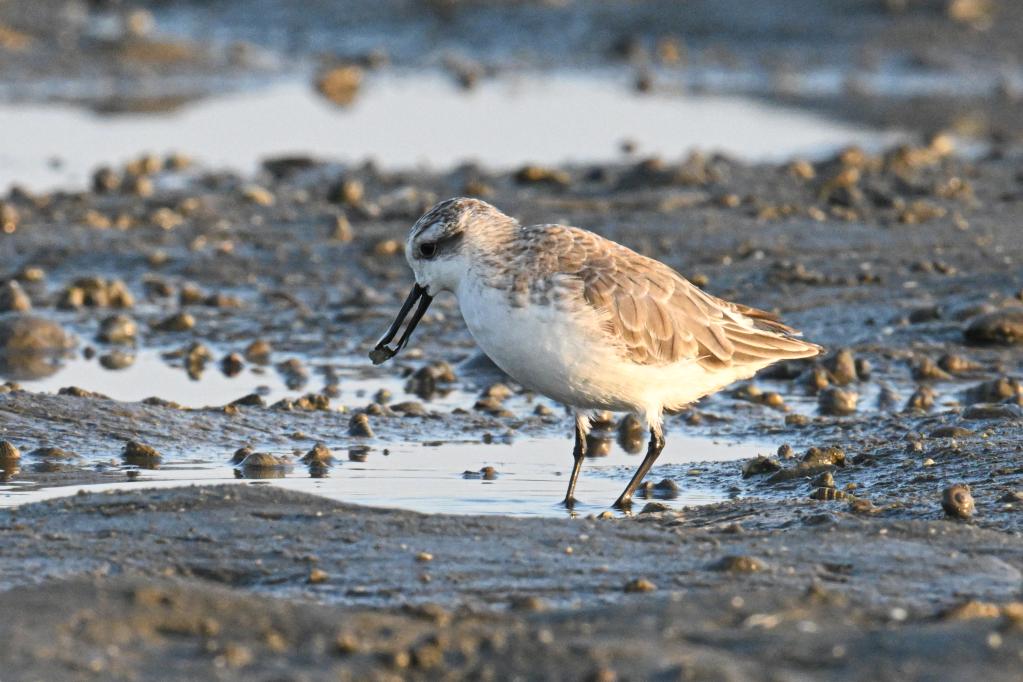Xinhua News Agency, Beijing, June 5th Title: Migratory birds move and fly, sharing fate and common destiny — — Practical observation of ecological civilization in China
Xinhua News Agency reporter Luo Qi Wei Mengjia Cheng Yunjie
As the sun sets in the west, hundreds of birds hover in the Wulong Pavilion of Beihai Park.
"I am very excited, my old friend is back." One day in early April, Beijing citizen Zhang Liting quickly recorded the location and number of these birds and shared the news with volunteer friends in the WeChat group.
Every spring, Beijing Swift, which overwinters from southern Africa, will experience an epic flight, leap over the Red Sea, cross Inner Mongolia and arrive in Beijing — — Their important habitats and breeding grounds.
Zhang Liting is the leader of the observation point of Beihai Park, a scientific investigation project of Beijing Swift. She and her volunteer partners made a special trip to Beihai Park at least once a week to take photos of the Swift population here, which not only provided basic monitoring data for the survey of migratory birds, but also contributed to the protection of migratory birds.
Every year, billions of migratory birds migrate across continents. Of the nine migratory routes in the world, four pass through China. On the important migration routes related to the survival and reproduction of migratory birds in the world, more and more Chinese loves and protects birds with the heart of common destiny and the wisdom of ecological innovation, and the modern vision of harmonious coexistence between man and nature is becoming a sensible reality.
Caring — — Building a "migrant-friendly" city
Beijing Swift is a subspecies of common Swift in Beijing. In 1870, a British scientist first discovered the specimen of Swift in Beijing, and named this kind of bird with long and narrow wings and resembling a sickle "Beijing Swift".
In the eyes of many Beijing residents like Zhang Liting, Beijing Swift is the "image ambassador" of Beijing. It is the only bird named after Beijing. The prototype of Nini, the mascot of the 2008 Beijing Olympic Games, is Beijing Swift.
In addition to Beijing Swift, every spring, a large number of migratory birds such as cranes, black storks and gulls migrate from south to north via Beijing.
During the investigation and interview, the reporter found that there are many bird-friendly buildings in Beijing. Located in the northwest of Beijing, Guanting Reservoir National Wetland Park Museum is a typical representative. The cracks between the skins of this building can be used for birds to build nests, and its glass curtain wall has specially adopted a grid-like design with more sensitive bird vision, which can effectively prevent birds from hitting.

A flock of cranes are flying in Guanting Reservoir National Wetland Park in Huailai County. Xinhua News Agency reporter Yang Shizhen photo
In addition, Beijing is committed to improving the quality of forests in mountainous areas, restoring wetland ecosystems and providing necessary habitats, food and water for birds. Since 2017, Beijing has built nearly 60 urban forests with "close to nature" characteristics, and built artificial shrubs and ecological islands.
Volunteers of the Beijing Swift Scientific Investigation Project found that more and more Swifts built "new homes" between the gaps of overpasses and skyscrapers. "Swift is gradually adapting to the urban life in Beijing." Zhang Liting said.
In February this year, China officially launched the National bird migration Passage Protection Action. The National Forestry and Grassland Bureau issued the National bird migration Passage Protection Action Plan (2021— In 2035), it is clear that 1140 places such as the Ming Tombs Reservoir in Changping District of Beijing and Poyang Lake in Jiangxi Province are important breeding sites, wintering sites and migration stopovers for migratory birds.
"With the restoration of the ecological environment and the strengthening of people’s awareness of ecological protection, I hope that in the future cities, people and birds will become the best ‘ Neighbor ’ Can live more harmoniously under the same sky. " Beijing Forestry University East Asia — Jia Yifei, a young researcher at the Australasian Migratory Bird Migration Research Center, said.
Guarding — — Revive the migratory birds’ homes.
Bird migration is a long and dangerous process, and the migration distance is often thousands of kilometers. From October every year to April the following year, the globally endangered species black-faced spoonbill, together with tens of thousands of migratory birds, will gather in the southeast coastal areas of China such as Funing Bay and Luoyuan Bay in Fujian for the winter.
"It was difficult to see black-faced spoonbills before, but now they appear every year, and the number is basically stable at hundreds." Zheng Zhiwu, a senior birdwatcher in Fujian, said that the wetland environment has improved year by year, and rare birds have become "frequent visitors".
The reporter saw in Luoyuan Bay that 10,000 mu of lush mangroves formed green waves under the sea breeze, which separated the beach where birds lived from the activity area of local residents, greatly reducing the impact of human activities on migratory birds.

Curly-feathered pelicans swim in Luoyuan Bay, Luoyuan County. Xinhua News Agency reporter Mei Yongcun photo
Yu Sunli, a resident near Luoyuan Bay, told reporters that local villagers have been eating the sea for generations, and aquaculture is the main industry. Improper breeding behavior once affected the habitat of local waterfowl, and the ecological balance was once destroyed.
In order to revitalize the wetland, the local marine ecological protection and restoration projects have been implemented, and a large number of aquaculture ponds have been transformed into high-tide waterfowl habitats. Many birdwatching plank roads have also been built in nearby fishing villages, and ecological birdwatching tourism has become a "new business card" for local development.
Yu Sunli opened a restaurant near the mangrove wetland park in Luoyuan Bay. "The ecological improvement of Luoyuan Bay in recent years has not only made it a paradise for migratory birds and bird friends, but also brought tangible benefits to our locals." Yu Sunli said.
The development of Luoyuan Bay is a microcosm of China’s comprehensive promotion of wetland protection and restoration, from excessive demand for nature to meticulous care for nature.
Since joining the Convention on Wetlands in 1992, China has successively passed the Law of People’s Republic of China (PRC) on Wetland Protection and several local regulations on wetland protection, thus building a legal barrier for wetland protection.
At present, there are 82 wetlands of international importance in China, ranking fourth in the world. Thirteen cities have won the title of international wetland city, and more than 600 wetland nature reserves and 900 national wetland parks have been established, with wetlands accounting for more than 50% of all nature reserves.
"Year after year, migratory birds come back. The living environment of birds has improved, and there are more people who protect and love birds. This is the change and strength brought about by social progress. " Zheng Zhiwu said.
Cooperation — — Beyond the time and space of fate and common.
In the world’s busiest migratory bird lifeline — — The spoon-billed snipe is one of the rarest waterfowl on the migratory passage of birds in East Asia-Australasia. During the migration period, the snipe will stop at the Tiaozi Mud Wetland in Dongtai, Yancheng, Jiangsu Province, and Beijiatujiao, Zhanjiang, Guangdong Province to feed and molt.

The world’s rare bird, the snipe, forages in Danzhou Bay wetland, Hainan. Xinhua News Agency reporter Pu Xiaoxu photo
"The characteristics of migratory birds determine that their protection achievements are closely related to every link in the passage path. The East Asia-Australasia bird migration channel involves more than 20 countries and regions, and strengthening international cooperation is a must. " Guan Lei, manager of Bird Flying Project of Beijing Entrepreneur Environmental Protection Foundation, said.
The reporter learned that at present, the protection of migratory birds’ migration routes still faces challenges such as habitat fragmentation, insufficient capital investment and imbalance between regions.
"Only by protecting migratory birds’ habitats with the help of global forces and promoting the construction of a community of life can we provide more effective protection for migratory birds." Jia Yifei said.
At present, China has signed bilateral agreements on the protection of migratory birds with Japan, South Korea, Australia, Russia, New Zealand and other countries, which are focusing on East Asia — Australasia Waterbird Partnership and other related content to carry out international cooperation, and actively participate in the "Belt and Road" migratory bird protection work.
Jia Yifei introduced that in the project to save the snipe, China’s scientific research team actively participated in the investigation and protection of breeding grounds and wintering grounds in countries along the migration routes such as Russia and Myanmar, organized synchronous investigation and monitoring, carried out breeding ground management education and training, and provided expert technical services, and achieved good results.
In 2019, the China Yellow Sea (Bohai Sea) Migratory Bird Habitat Heritage Declaration (Phase I) was officially listed in the World Heritage List, becoming one of only two intertidal wetland heritages in the world.
Guan Lei said: "This achievement not only helps to promote the global joint protection of the East Asia-Australasia bird migration route, but also injects a strong impetus into building a community of life on earth."
Another comfort to the guardians of migratory birds is that the younger generation is constantly joining the team of loving and protecting birds. In Beijing, Zhang Liting has an extra partner in the Swift Survey every week — — Her thirteen-year-old daughter.
"I believe that the figure of Beijing Swift will also become a beautiful memory of the sky for the next generation." Zhang Liting said.
关于作者